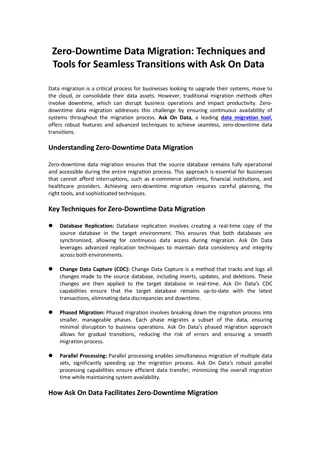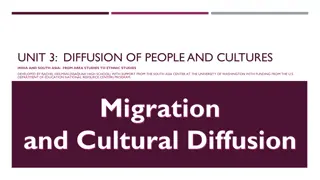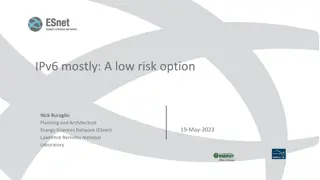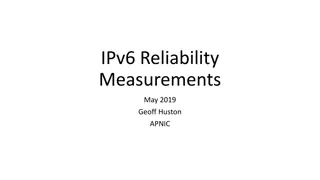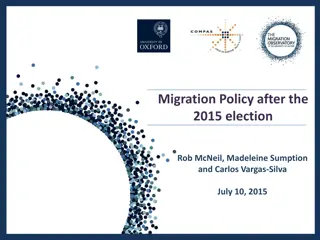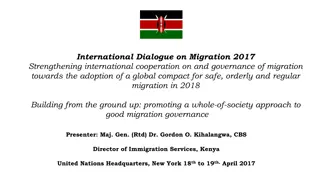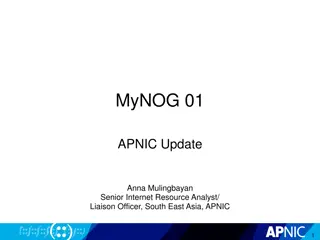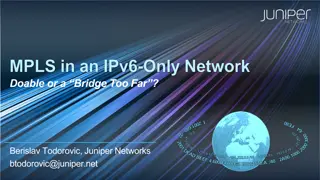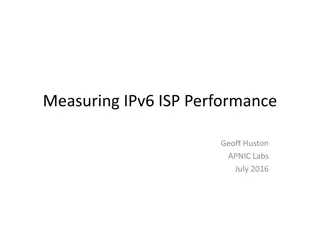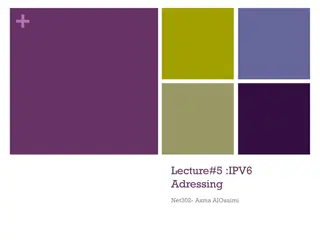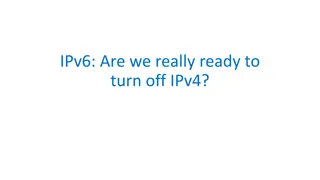Understanding IPv6 Addressing and Migration Techniques
IPv6 is designed as the successor to IPv4 due to the depletion of IPv4 address space. This lecture covers topics such as the need for IPv6, IPv4 and IPv6 coexistence techniques like dual-stack, tunneling, and translation, IPv6 addressing using the hexadecimal number system, and IPv6 address representation with 128 bits. The transition to IPv6 is essential with the exhaustion of IPv4 addresses and the increasing demands of the internet population.
Download Presentation

Please find below an Image/Link to download the presentation.
The content on the website is provided AS IS for your information and personal use only. It may not be sold, licensed, or shared on other websites without obtaining consent from the author. Download presentation by click this link. If you encounter any issues during the download, it is possible that the publisher has removed the file from their server.
E N D
Presentation Transcript
1 LECTURE#5 IPV6 ADDRESSING Asma AlOsaimi
Topics 2 IPv4 Issues IPv6 Address Representation IPv6 Types
IPv4 Issues The Need for IPv6 3 IPv6 is designed to be the successor to IPv4. Depletion of IPv4 address space has been the motivating factor for moving to IPv6. Projections show that all five Regional Internet registry (RIRs) will run out of IPv4 addresses between 2015 and 2020. RIR is an organization that manages the allocation and registration of Internet number resources within a particular region of the world. With an increasing Internet population, a limited IPv4 address space, issues with NAT and an Internet of things, the time has come to begin the transition to IPv6! IPv4 has a theoretical maximum of 4.3 billion addresses, plus private addresses in combination with NAT. IPv6 larger 128-bit address space which create 340 undecillion addresses. IPv6 fixes the limitations of IPv4 and includes additional enhancements, such as ICMPv6.
IPv4 Issues IPv4 and IPv6 Coexistence 4 The migration techniques can be divided into three categories: Dual-stack, Tunnelling, and Translation. Dual-stack Dual-stack: Allows IPv4 and IPv6 to coexist on the same network. Devices run both IPv4 and IPv6 protocol stacks simultaneously.
IPv4 Issues IPv4 and IPv6 Coexistence (cont.) 5 Tunnelling Tunnelling: A method of transporting an IPv6 packet over an IPv4 network. The IPv6 packet is encapsulated inside an IPv4 packet.
IPv4 Issues IPv4 and IPv6 Coexistence (cont.) 6 Translation Translation: The Network Address Translation 64 (NAT64) allows IPv6- enabled devices to communicate with IPv4-enabled devices using a translation technique similar to NAT for IPv4. An IPv6 packet is translated to an IPv4 packet, and vice versa.
IPv6 Addressing Hexadecimal Number System 7 Hexadecimal is a base sixteen system. Base 16 numbering system uses the numbers 0 to 9 and the letters A to F. Four bits (half of a byte) can be represented with a single hexadecimal value.
IPv6 Addressing IPv6 Address Representation 8 128 bits in length and written as a string of hexadecimal values In IPv6, 4 bits represents a single hexadecimal digit, 32 hexadecimal value = IPv6 address 2001:0DB8:0000:1111:0000:0000:0000:0200 FE80:0000:0000:0000:0123:4567:89AB:CDEF Hextet used to refer to a segment of 16 bits or four hexadecimals Can be written in either lowercase or uppercase 4 hexadecimal digit s= 16 binary digits
IPv6 Addressing IPv6 Address Representation(cont.) 9 Example #1 Example #2
Types of IPv6 Addresses IPv6 Prefix Length 10 IPv6 does not use the dotted-decimal subnet mask notation Prefix length indicates the network portion of an IPv6 address using the following format: IPv6 address/prefix length Prefix length can range from 0 to 128 Typical prefix length is /64
Types of IPv6 Addresses IPv6 Address Types 11 There are three types of IPv6 addresses: Unicast Multicast Anycast. Note: IPv6 does not have broadcast addresses.
Types of IPv6 Addresses IPv6 Unicast Addresses 12 Unicast Uniquely identifies an interface on an IPv6-enabled device. Sending From a single source to a single destination.
Types of IPv6 Addresses IPv6 Unicast Addresses (cont.) 13
Types of IPv6 Addresses IPv6 Unicast Addresses (cont.) 14 Global Unicast Similar to a public IPv4 address Globally unique & Internet routable addresses Can be configured statically or assigned dynamically Link-local Used to communicate with other devices on the same local link (LAN). Confined to a single link; not routable beyond the link FE80::/10 range, first 10 bits are 1111 1110 10xx xxxx 1111 1110 1000 0000 (FE80) - 1111 1110 1011 1111 (FEBF)
Types of IPv6 Addresses IPv6 Unicast Addresses (cont.) 15 Loopback Similar to 127.0.0.0 in IPv4 Used by a host to send a packet to itself and cannot be assigned to a physical interface. Ping an IPv6 loopback address to test the configuration of TCP/IP on the local host. All-0s except for the last bit, represented as ::1/128 or just ::1. Unspecified Address All-0 s address represented as ::/128 or just :: An unspecified address is used as a source address when the device does not yet have a permanent IPv6 address or when the source of the packet is irrelevant to the destination.
Types of IPv6 Addresses IPv6 Unicast Addresses (cont.) 16 Unique Local Similar to private addresses for IPv4. Used for local addressing within a site or between a limited number of sites. In the range of FC00::/7 to FDFF::/7. IPv4 Embedded (not covered in this course) Used to help transition from IPv4 to IPv6.
IPv6 Unicast Addresses Structure of an IPv6 Global Unicast Address (cont.) 17 A global unicast address has three parts: Global Routing Prefix, Subnet ID, and Interface ID. 1) Global Routing Prefix network portion of the address assigned by the ISP provider to a customer or site, currently, RIR s assign a /48 global routing prefix to customers. 2001:0DB8:ACAD::/48 has a prefix that indicates that the first 48 bits (2001:0DB8:ACAD) is the prefix or network portion.
IPv6 Unicast Addresses Structure of an IPv6 Global Unicast Address (cont.) 18 2) Subnet ID is used by an organization to identify subnets within its site 3) Interface ID Equivalent to the host portion of an IPv4 address.
IPv6 Unicast Addresses Static Configuration of a Global Unicast Address 19
IPv6 Unicast Addresses Static Configuration of an IPv6 Global Unicast Address (cont.) 20 Windows IPv6 Setup
IPv6 Unicast Addresses Dynamic Link-local Addresses 21 Link-Local Address After a global unicast address is assigned to an interface, an IPv6-enabled device automatically generates its link-local address. Must have a link-local address that enables a device to communicate with other IPv6-enabled devices on the same subnet. Uses the link-local address of the local router for its default gateway IPv6 address. Routers exchange dynamic routing protocol messages using link-local addresses. Routers routing tables use the link-local address to identify the next-hop router when forwarding IPv6 packets.
IPv6 Unicast Addresses Dynamic Link-local Addresses (cont.) 22 Dynamically Assigned The link-local address is dynamically created using the FE80::/10 prefix and the Interface ID.
IPv6 Unicast Addresses Static Link-local Addresses 23 Configuring Link-local
IPv6 Unicast Addresses Static Link-local Addresses (cont.) 24 Configuring Link-local
IPv6 Global Unicast Addresses Verifying IPv6 Address Configuration 25 Each interface has two IPv6 addresses - 1. global unicast address that was configured one that begins with FE80 is automatically added as a link-local unicast address 2.
IPv6 Global Unicast Addresses Verifying IPv6 Address Configuration (cont.) 26
IPv6 Multicast Addresses Assigned IPv6 Multicast Addresses 27 IPv6 multicast addresses have the prefix FF00::/8 There are two types of IPv6 multicast addresses: Assigned multicast Solicited (Requested) node multicast
IPv6 Multicast Addresses Assigned IPv6 Multicast Addresses (cont.) 28 Two common IPv6 assigned multicast groups include: FF02::1 All-nodes multicast group All IPv6-enabled devices join Same effect as an IPv4 broadcast address FF02::2 All-routers multicast group All IPv6 routers join A router becomes a member of this group when it is enabled as an IPv6 router with theipv6 unicast- routing global configuration mode command. A packet sent to this group is received and processed by all IPv6 routers on the link or network.
IPv6 Multicast Addresses Solicited Node IPv6 Multicast Addresses 29 Similar to the all-nodes multicast address Automatically created when the global unicast or link-local unicast addresses are assigned
IPv6 Multicast Addresses Solicited Node IPv6 Multicast Addresses (cont.) 30 The solicited node multicast address consists of two parts: FF02:0:0:0:0:0:FF00::/104 multicast prefix First 104 bits of the all solicited node multicast address Least significant 24-bits Copied from the right-most 24 bits of the global unicast or link-local unicast address of the device


